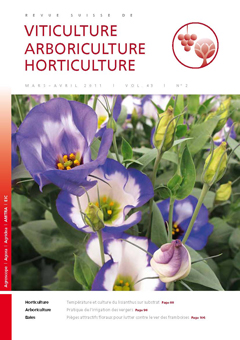
Issue 2 - March - April 2011
Abstract in open access
The aim of the present study was to assess the influence of root area heating on stem quality for a lisianthus (Eustoma exaltatum ssp. russellianum) winter crop. Plants were soilless cultivated in greenhouse with low set-point temperature (13/15-17 °C, night/day ? aeration temperature). Three treatments were compared in the first trial between December 2008 and June 2009: no root area heating, 17 °C and 22 °C in the root area throughout the duration of the crop. Three treatments were tested in the 2009-2010 trial: no root area heating, 22 °C heating throughout the duration of the crop and 22 °C until stage 7-8 pairs of leaves. For both trials, results showed that heating the root area has a positive effect on leaves number, stem length and diameter during the early stages of the culture. At the end of the culture, stem mortality was clearly lower and stem length was significantly higher with the heating treatments. However, no difference was measured concerning the number of flower buds per stem. A simplified balance sheet of costs and financial returns of culture showed that the heating treatments allowed an added value of 21.50 CHF/m2 in the 2009-2010 trial. In 2009-2010, the treatment heated until 7-8 pairs of leaves allowed an added value of 26.40 CHF/m2 and 9.40 CHF/m2 respectively compared to not heated treatment and to heating throughout the duration of the culture. In conclusion, in order to improve the profitability of a winter lisianthus culture with a low set-point temperature, heating the root area at 22 °C until the stage 7-8 pairs of leaves is recommended.
Keywords: lisianthus, Eustoma exaltatum, root area heating, soilless culture.
E-Mail: pascal.sigg@acw.admin.ch
Adress:
Abstract in open access
The raspberry beetle (Byturus tomentosus DeGeer) is one of the major pests in raspberry mountain crops. The attractiveness and efficiency of a new type of attractive floral trap developed by the Scottish Crop Institute (SCRI) were tested against this pest. Fifty traps per hectare were displayed in 2008 right before raspberry flowering and proved to be immediately attractive. In 2009 and 2010, the same number of traps were installed, respectively two and four weeks earlier than in 2008. The earlier traps captured the bigger number of insects. These results show that pests activity in the raspberry plantation is earlier than expected. By capturing a great number of pests before raspberry flowering, floral attractive traps allow decreasing fruit damages. After three years trapping on one of the plots, the damages decreased of more than 60 % (9.6 % damaged fruits in 2008 vs 3.3 % in 2010). These encouraging results mean that these traps are valuable detection tools, and in the long run also reduce pest population.
Keywords: soft fruits, raspberry, monitoring, Byturus tomentosus, semiochemical traps
E-Mail: catherine.baroffio@acw.admin.ch
Adress:
Abstract in open access
Brown mustard, canola and rye were used to control two soilborne diseases, Verticillium wilt (caused by Verticillium dahliae) and corky root (Pyrenochaeta lycopersici) in a series of pot trials. The average reduction of the number of V. dahliae microsclerotia by the green manures was 50 %. This reduction was strongly influenced by the green manure species, but also by the soil type. The microbial activity of the soil, enhanced by the green manures, led to a diminution of V. dahliae microsclerotia. For the control of corky root, the efficacy of a brown mustard with a high glucosinolate content was similar to steam sterilizing the soil. In contrast, rye had no effect against this disease.
Keywords: biofumigation, corky root, microbial activity,soil type, Verticillium dahliae
E-Mail: vincent.michel@acw.admin.ch
Adress:
Abstract in open access
The aim of the study was to find the causes for the lack of firmness and for damages caused by soft scald in Gala apples after storage. Therefore fruit samples were collected from fifteen orchards since 1999. The analysis of fruit maturity at harvest showed that some orchards were harvested too late, what may partly explain the causes for quality problems after storage. These analysis at harvest also pointed out that the starch index is the best indicator of fruit maturity to predict the storage duration. In order to harvest the Gala apples earlier, the reference values for the starch index were modified to 4-6 instead of 5-7. A further observation of these studies was, that in the years of hot weather conditions especially in summer, the storage was more difficult and soft scald damages occurred more frequently. After eleven years of research, this study gives solutions for the production and the storage to reduce the risk of fruits damages and to maintain the quality of Gala apples.
Keywords: firmness, quality, scald, storage diseases
E-Mail: jean-pierre.siegrist@acw.admin.ch
Adress:

 Download of full issue
Download of full issue
 Download article
Download article